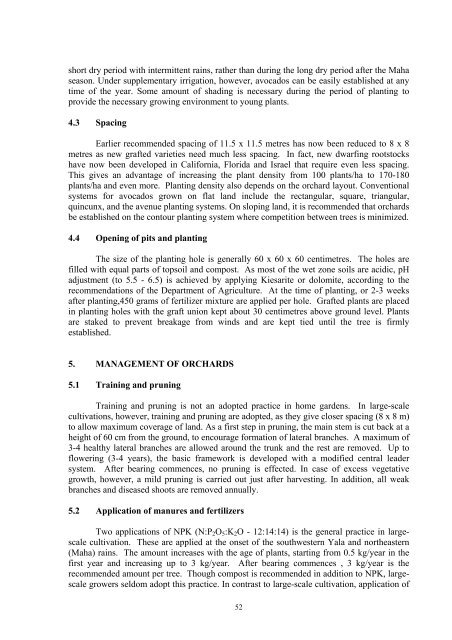Avocado Production in Asia and the Pacific - United Nations in ...
Avocado Production in Asia and the Pacific - United Nations in ...
Avocado Production in Asia and the Pacific - United Nations in ...
Create successful ePaper yourself
Turn your PDF publications into a flip-book with our unique Google optimized e-Paper software.
short dry period with <strong>in</strong>termittent ra<strong>in</strong>s, ra<strong>the</strong>r than dur<strong>in</strong>g <strong>the</strong> long dry period after <strong>the</strong> Maha<br />
season. Under supplementary irrigation, however, avocados can be easily established at any<br />
time of <strong>the</strong> year. Some amount of shad<strong>in</strong>g is necessary dur<strong>in</strong>g <strong>the</strong> period of plant<strong>in</strong>g to<br />
provide <strong>the</strong> necessary grow<strong>in</strong>g environment to young plants.<br />
4.3 Spac<strong>in</strong>g<br />
Earlier recommended spac<strong>in</strong>g of 11.5 x 11.5 metres has now been reduced to 8 x 8<br />
metres as new grafted varieties need much less spac<strong>in</strong>g. In fact, new dwarf<strong>in</strong>g rootstocks<br />
have now been developed <strong>in</strong> California, Florida <strong>and</strong> Israel that require even less spac<strong>in</strong>g.<br />
This gives an advantage of <strong>in</strong>creas<strong>in</strong>g <strong>the</strong> plant density from 100 plants/ha to 170-180<br />
plants/ha <strong>and</strong> even more. Plant<strong>in</strong>g density also depends on <strong>the</strong> orchard layout. Conventional<br />
systems for avocados grown on flat l<strong>and</strong> <strong>in</strong>clude <strong>the</strong> rectangular, square, triangular,<br />
qu<strong>in</strong>cunx, <strong>and</strong> <strong>the</strong> avenue plant<strong>in</strong>g systems. On slop<strong>in</strong>g l<strong>and</strong>, it is recommended that orchards<br />
be established on <strong>the</strong> contour plant<strong>in</strong>g system where competition between trees is m<strong>in</strong>imized.<br />
4.4 Open<strong>in</strong>g of pits <strong>and</strong> plant<strong>in</strong>g<br />
The size of <strong>the</strong> plant<strong>in</strong>g hole is generally 60 x 60 x 60 centimetres. The holes are<br />
filled with equal parts of topsoil <strong>and</strong> compost. As most of <strong>the</strong> wet zone soils are acidic, pH<br />
adjustment (to 5.5 - 6.5) is achieved by apply<strong>in</strong>g Kiesarite or dolomite, accord<strong>in</strong>g to <strong>the</strong><br />
recommendations of <strong>the</strong> Department of Agriculture. At <strong>the</strong> time of plant<strong>in</strong>g, or 2-3 weeks<br />
after plant<strong>in</strong>g,450 grams of fertilizer mixture are applied per hole. Grafted plants are placed<br />
<strong>in</strong> plant<strong>in</strong>g holes with <strong>the</strong> graft union kept about 30 centimetres above ground level. Plants<br />
are staked to prevent breakage from w<strong>in</strong>ds <strong>and</strong> are kept tied until <strong>the</strong> tree is firmly<br />
established.<br />
5. MANAGEMENT OF ORCHARDS<br />
5.1 Tra<strong>in</strong><strong>in</strong>g <strong>and</strong> prun<strong>in</strong>g<br />
Tra<strong>in</strong><strong>in</strong>g <strong>and</strong> prun<strong>in</strong>g is not an adopted practice <strong>in</strong> home gardens. In large-scale<br />
cultivations, however, tra<strong>in</strong><strong>in</strong>g <strong>and</strong> prun<strong>in</strong>g are adopted, as <strong>the</strong>y give closer spac<strong>in</strong>g (8 x 8 m)<br />
to allow maximum coverage of l<strong>and</strong>. As a first step <strong>in</strong> prun<strong>in</strong>g, <strong>the</strong> ma<strong>in</strong> stem is cut back at a<br />
height of 60 cm from <strong>the</strong> ground, to encourage formation of lateral branches. A maximum of<br />
3-4 healthy lateral branches are allowed around <strong>the</strong> trunk <strong>and</strong> <strong>the</strong> rest are removed. Up to<br />
flower<strong>in</strong>g (3-4 years), <strong>the</strong> basic framework is developed with a modified central leader<br />
system. After bear<strong>in</strong>g commences, no prun<strong>in</strong>g is effected. In case of excess vegetative<br />
growth, however, a mild prun<strong>in</strong>g is carried out just after harvest<strong>in</strong>g. In addition, all weak<br />
branches <strong>and</strong> diseased shoots are removed annually.<br />
5.2 Application of manures <strong>and</strong> fertilizers<br />
Two applications of NPK (N:P 2 O 5 :K 2 O - 12:14:14) is <strong>the</strong> general practice <strong>in</strong> largescale<br />
cultivation. These are applied at <strong>the</strong> onset of <strong>the</strong> southwestern Yala <strong>and</strong> nor<strong>the</strong>astern<br />
(Maha) ra<strong>in</strong>s. The amount <strong>in</strong>creases with <strong>the</strong> age of plants, start<strong>in</strong>g from 0.5 kg/year <strong>in</strong> <strong>the</strong><br />
first year <strong>and</strong> <strong>in</strong>creas<strong>in</strong>g up to 3 kg/year. After bear<strong>in</strong>g commences , 3 kg/year is <strong>the</strong><br />
recommended amount per tree. Though compost is recommended <strong>in</strong> addition to NPK, largescale<br />
growers seldom adopt this practice. In contrast to large-scale cultivation, application of<br />
52
















